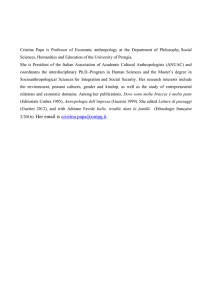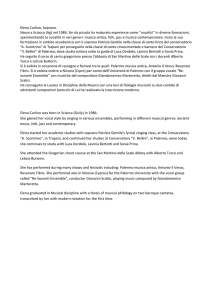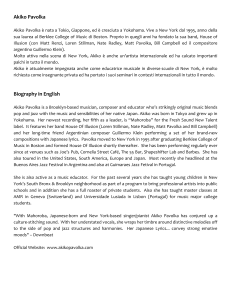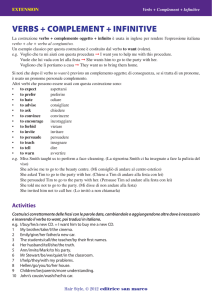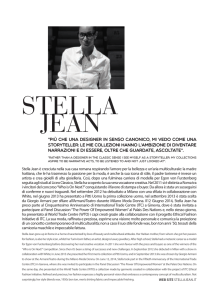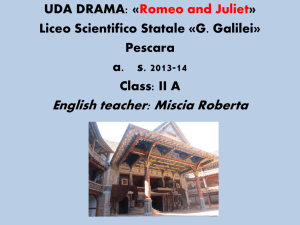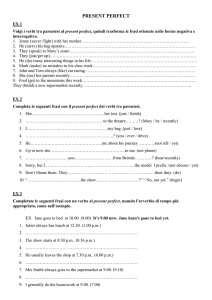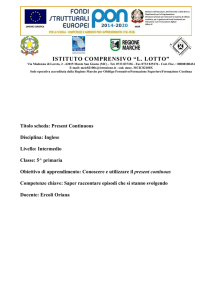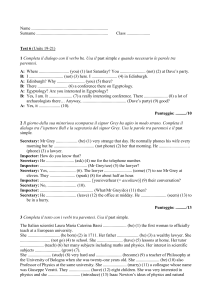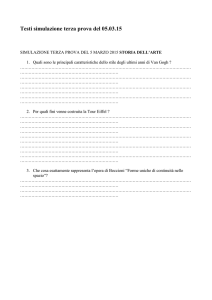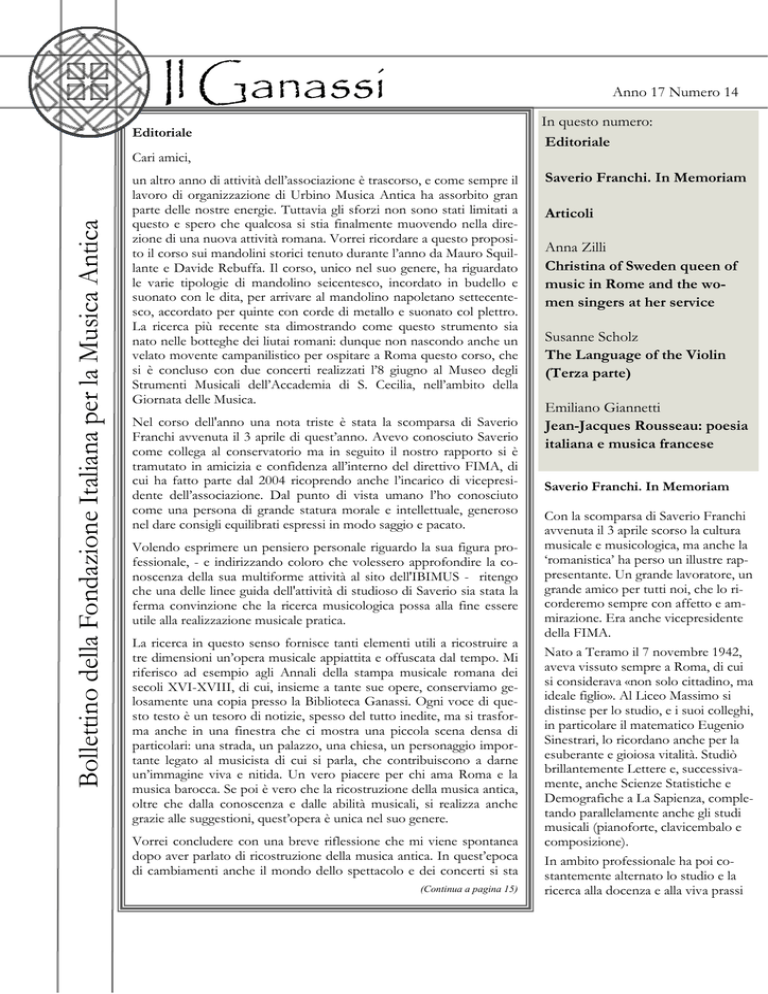
Il Ganassi
Anno 17 Numero 14
In questo numero:
Editoriale
Editoriale
Bollettino della Fondazione Italiana per la Musica Antica
Cari amici,
un altro anno di attività dell’associazione è trascorso, e come sempre il
lavoro di organizzazione di Urbino Musica Antica ha assorbito gran
parte delle nostre energie. Tuttavia gli sforzi non sono stati limitati a
questo e spero che qualcosa si stia finalmente muovendo nella direzione di una nuova attività romana. Vorrei ricordare a questo proposito il corso sui mandolini storici tenuto durante l’anno da Mauro Squillante e Davide Rebuffa. Il corso, unico nel suo genere, ha riguardato
le varie tipologie di mandolino seicentesco, incordato in budello e
suonato con le dita, per arrivare al mandolino napoletano settecentesco, accordato per quinte con corde di metallo e suonato col plettro.
La ricerca più recente sta dimostrando come questo strumento sia
nato nelle botteghe dei liutai romani: dunque non nascondo anche un
velato movente campanilistico per ospitare a Roma questo corso, che
si è concluso con due concerti realizzati l’8 giugno al Museo degli
Strumenti Musicali dell’Accademia di S. Cecilia, nell’ambito della
Giornata delle Musica.
Nel corso dell'anno una nota triste è stata la scomparsa di Saverio
Franchi avvenuta il 3 aprile di quest’anno. Avevo conosciuto Saverio
come collega al conservatorio ma in seguito il nostro rapporto si è
tramutato in amicizia e confidenza all’interno del direttivo FIMA, di
cui ha fatto parte dal 2004 ricoprendo anche l’incarico di vicepresidente dell’associazione. Dal punto di vista umano l’ho conosciuto
come una persona di grande statura morale e intellettuale, generoso
nel dare consigli equilibrati espressi in modo saggio e pacato.
Volendo esprimere un pensiero personale riguardo la sua figura professionale, - e indirizzando coloro che volessero approfondire la conoscenza della sua multiforme attività al sito dell'IBIMUS - ritengo
che una delle linee guida dell'attività di studioso di Saverio sia stata la
ferma convinzione che la ricerca musicologica possa alla fine essere
utile alla realizzazione musicale pratica.
La ricerca in questo senso fornisce tanti elementi utili a ricostruire a
tre dimensioni un’opera musicale appiattita e offuscata dal tempo. Mi
riferisco ad esempio agli Annali della stampa musicale romana dei
secoli XVI-XVIII, di cui, insieme a tante sue opere, conserviamo gelosamente una copia presso la Biblioteca Ganassi. Ogni voce di questo testo è un tesoro di notizie, spesso del tutto inedite, ma si trasforma anche in una finestra che ci mostra una piccola scena densa di
particolari: una strada, un palazzo, una chiesa, un personaggio importante legato al musicista di cui si parla, che contribuiscono a darne
un’immagine viva e nitida. Un vero piacere per chi ama Roma e la
musica barocca. Se poi è vero che la ricostruzione della musica antica,
oltre che dalla conoscenza e dalle abilità musicali, si realizza anche
grazie alle suggestioni, quest’opera è unica nel suo genere.
Vorrei concludere con una breve riflessione che mi viene spontanea
dopo aver parlato di ricostruzione della musica antica. In quest’epoca
di cambiamenti anche il mondo dello spettacolo e dei concerti si sta
(Continua a pagina 15)
Saverio Franchi. In Memoriam
Articoli
Anna Zilli
Christina of Sweden queen of
music in Rome and the women singers at her service
Susanne Scholz
The Language of the Violin
(Terza parte)
Emiliano Giannetti
Jean-Jacques Rousseau: poesia
italiana e musica francese
Saverio Franchi. In Memoriam
Con la scomparsa di Saverio Franchi
avvenuta il 3 aprile scorso la cultura
musicale e musicologica, ma anche la
‘romanistica’ ha perso un illustre rappresentante. Un grande lavoratore, un
grande amico per tutti noi, che lo ricorderemo sempre con affetto e ammirazione. Era anche vicepresidente
della FIMA.
Nato a Teramo il 7 novembre 1942,
aveva vissuto sempre a Roma, di cui
si considerava «non solo cittadino, ma
ideale figlio». Al Liceo Massimo si
distinse per lo studio, e i suoi colleghi,
in particolare il matematico Eugenio
Sinestrari, lo ricordano anche per la
esuberante e gioiosa vitalità. Studiò
brillantemente Lettere e, successivamente, anche Scienze Statistiche e
Demografiche a La Sapienza, completando parallelamente anche gli studi
musicali (pianoforte, clavicembalo e
composizione).
In ambito professionale ha poi costantemente alternato lo studio e la
ricerca alla docenza e alla viva prassi
Bollettino della Fondazione Italiana per la Musica Antica
Christina of Sweden queen of music in Rome and the women singers at her service
Una
Annanuova
Zilli luce sull’Ars Nova di Francesco Landini
di Anna Chiappinelli
Queen Christina of Sweden chose the eternal city as the perfect
setting to carry out her dream of creating a lively cultural circle
where all the best artists, intellectuals and musicians could offer
their contribution. When she arrived in Rome in December 1655
after leaving her country, her throne and religion, she became one
of the main patronesses of musicians and promoters of music:
she employed some of the best composers available at the time:
Giacomo Carissimi, Alessandro Scarlatti, Arcangelo Corelli, Bernardo Pasquini, to name but a few. Many were the singers at her
service, especially castrati, some of whom were borrowed from the
Sistine Chapel; she also protected and employed a number of
women singers, and when she opened the first public theatre in
Rome, the Teatro Tordinona, inaugurated in 1671, she obtained
the licence to let women perform on a public stage - which was
quite a revolutionary event for Rome, a city whose life had always
been subject to the popes’ whims.
At her court in Palazzo Riario she had set up a sort of music
school for women singers: they had the best musicians the world
could offer at their disposal, they enjoyed the protection of the
greatest patroness in Rome and they even resided at the palace.
The training of women singers was exclusively a private one; they
were not admitted to the numerous schools disseminated in the
eternal city. Furthermore, they were given a good number of occasions to perform at the palace for public events or during the
Accademia Reale, whose sessions were held regularly at Palazzo
Riario.
Towards the first half of the 17th century Rome was so saturated
with singers that these began to travel all over Italy in search for
work: the so called “Romanine” - Roman women singers - were
famous for their talents and abilities and were much appreciated
in many courts and theatres all over Italy. Women singers were
the ones who travelled the most, because of the bans that popes
would regularly issue against their performing publicly and in
churches; they often married musicians and singers, which would
help them find work and would make their financial lives easier.
Christina had only four women singers at her permanent service,
but she would occasionally hire other women singers for special
events or performances. We learn about a certain “Centoventi”,
who performed at the Tordinona and of a “Tiepola” rival of the
Centoventi, who performed on the same stage. We also learn about
another singer, Elena Passarelli, to whom the poet Sebastiano
Baldini dedicated a number of sonnets. Among the singers at her
occasional service there was also Anna Maria Scarlatti, sister to
the famous composer Alessandro. The documents I found about
the singer give no proof about her presence on the stage of the
Tordinona or on the stage of Palazzo Riario. Apparently she
helped her brother advance in his career in Naples, thanks to her
beauty and the protection that she had obtained from powerful
men.
The following paragraphs illustrate the lives and careers of the
four “canterine” at the service of Christina of Sweden: Antonia
Coresi, Maria Landini, Angelica Quadrelli and Angela Voglia.
Antonia Coresi
Roman-born Antonia Coresi may be considered among the
great sopranos of her time, as she performed in the most prestigious theatres in Italy. Wife of Nicola Coresi, another virtuoso
singer, they had been both at the service of Queen Christina of
2
Sweden since 1670. A number of sonnets written by the poet
Sebastiano Baldini describe her as “musician to her Majesty the
Queen of Sweden” and prove that she was a virtuoso singer. The
Coresis were also hired occasionally by the constable Colonna in
Rome. Antonia Coresi played the role of Scipio, the protagonist
of the opera Scipione Affricano, by Francesco Cavalli and Alessandro Stradella, which inaugurated the theatre Tordinona in January 1671. Antonia was much appreciated; Christina presented
her with a gift of a painting, a copy of Correggio’s Leda col cigno
made by Carlo Maratta. The Duke of Mantua, Ferdinand Gonzaga, requested her for the performance of an opera to be held at
his court in the spring of 1674. She travelled to different Italian
cities and performed in the most prestigious theatres; these are
the steps in her career before she began her service for Christina.
She is employed in Venice from 1655 to 1668, performing in the
Tito by M.A. Cesti at the theatre SS. Giovanni e Paolo, in the Dori
by Cesti and in the Eliogabalo by Cavalli. Antonia results among
the singers employed in the role of Martia in the opera Il Coriolano, performed in the Teatro Ducale in Piacenza in 1669, dedicated
to Ranuccio II Farnese and Maria Princess D'Este, with libretto
by Christoforo Ivanovich and music by Francesco Cavalli. Furthermore, the Venetian impresario Marco Faustini, who worked
for the main theatres in Venice and collaborated with the best
composers of the time – among whom Cesti and Cavalli - employed many famous singers: Anna Renzi, Giulia Masotti and
Antonia Coresi. Whilst at the service of Queen Christina, Antonia
continued to perform in Venice, where we find her in 1672 as a
singer in the Orfeo by Antonio Sartorio, at the Teatro S. Luca. She
was also among the interpreters of the serenata Damone e Clori, by
Alessandro Stradella, as is testified in the music score of Torino1,
together with the rival singer Giulia Masotti, who was occasionally
employed by Christina of Sweden.
Maria Landini, la “Mariuccia”
She was the illegitimate child of the marquise Orazio Del Monte e
of Fanchon, namely Francesca Portuì - Christina’s maid - who remained at her service until her death. The Queen had met her
during her stay in Paris; she had married her to captain Francesco
Landini from Pesaro, one of the men involved in the Monaldeschi
affair. Maria was born in 1667 or 1668 in Hamburg – according
to the anonymous author of the Historia degli intrighi galanti she was
born in 16702 - at Christina’s court, after Fanchon had a relationship with the marquise Del Monte, and she was educated in music
and trained in singing. Fanchon’s husband was furious at hearing
the news about the birth of the girl, but was then calmed down
and persuaded by rich gifts coming from the Queen herself. The
fact that we find her in different parts of Italy and Europe singing
in the best theatres and at the most prestigious courts is an evident proof of her talent and skills; she was not only a salon singer,
despite the fact that she performed in serenatas and private musical
events when she was at the service of Queen Christina in Rome –
she was often seen perform together with the other Queen’s favourite singer, Angela Voglia, “La Giorgina”. These are the few
information about her activities when she was in Rome.
In the Avvisi Marescotti we read that : «[in the evening of 12th July
1687] the Queen of Sweden organised a beautiful serenata where
the two excellent Giorgina and Landini sang…»3. We also find
her singing on the evening of 20th September 1688 a serenata in
Bollettino della Fondazione Italiana per la Musica Antica
honour of the French Ambassador Lavardin which took place in
the jasmine garden around the house of the marquise Orazio Del
Monte, her father, just opposite Palazzo Riario, close to the actual
Villa Farnesina4.The date became famous because it coincided
with the sudden death of the same marquise which occurred the
morning after due to a stroke.
Mariuccia apparently performed during the month of July and on
2nd September 1688, once again together with la Giorgina5. When
in Rome she was at the sole service of Christina; after her death
she was put to the service of the Duchess of Hannover in Germany and of the Duke of Mantua6. She performed for the latter in
many different operas, among which Il trionfo di Camilla Regina dei
Volsci, by Giovanni Bononcini in Mantua in 1698 and La fede ne’
tradimenti, by Attilio Ariosti, again in Mantua in 1699 in the role of
Anagilda. In the same year she performed in Duello d’Amore e di
Vendetta by Marc’Antonio Ziani in Venice; in La forza dell’amicizia
in Mantua in 1700, playing the role of Climene; in La pace generosa,
libretto by Francesco Silvani, in Venice in 1700, in the role of
Ismena; in Lucio Vero, in Genova in 1701 in the role of Berenice7.
She also performed in Leghorn during the Carnival of 16988.
She also sang during the Carnival of 1700 in Venice as a virtuosa of
the Duke of Mantua and in 1711 we find her at the San Cassiano,
where she is called Landini di Chateauneuf, using the surname of
her husband, the actor Chateauneuf, but also Landini di Castelnuovo9
She was an acclaimed singer and she was invited to the court of
Vienna where she met the composer and theorbo player Francesco Conti, whom she married in 1715 (after the death of her husband Chateauneuf); the two became some of the favourite musicians at court and there they led a happy and comfortable life.
From 1710 onwards she is engaged singing all the operas by Johann Joseph Fux, along with a number of other operas and oratorios. She was much appreciated by remarkable composers and
musicians like Benedetto Marcello. She probably died in 1722 in
mysterious circumstances.
Angelica Quadrelli
Out of the four singers who are the object of this study, Angelica
Quadrelli is the one we know less about. She was apparently a
very acclaimed theatre singer but also an excellent player of harpsichord, violin and oboe. She was also very beautiful - tall, blonde,
with bright eyes and cherry red lips - as the descriptions of the
contemporaries tell us; she was so attractive that Innocent XI, in
his moralising crusade, thought about shutting her up in a nunnery, together with all the other good-looking women singers.
Even Angelica Quadrelli was received under the protective wing
of Christina, who appreciated her voice and her music skills; she
gave her many opportunities to perform during the gatherings and
events she organised in Palazzo Riario. She was a singer for private music events and she also performed on a public stage; she
starred together with Antonia Coresi during the inauguration of
the theatre Tordinona in 1617, in the role of Sofonisba, Siface’s
wife, in the opera Scipione Affricano, as well as in the second opera
of the first season of the Tordinona, Novello Giasone, in the role of
Isifile, Queen of Lenno. She is mentioned in a number of other
operas, where she played leading roles. The poet Sebastiano Baldini wrote quite a few sonnets in praise of the singers’ skills. The
scholar Alberto Cametti believes that she sang more frequently at
the Tordinona than any other singer from the papal chapel like
Fede, Verdoni, Anatò and others. One of the Avvisi di Roma informs us about the death of Angelica Quadrelli which occurred in
Rome on 2nd April 167210 the singer had the chance to perform on
the stage of the Tordinona only during the first two seasons.
Angela Voglia, “ La Giorgina”.
Angela Maddalena Voglia was called “la Giorgina” probably because of her stepfather’s surname, Giacomo Giorgini. She was
born in Rome on 13th February 1666, in a house in via de’ Tolomei, in Trastevere, from a certain Francesco Voglia, a noble from
Camerino - who died when she was little older than four years –
and from Caterina Fracchi. The anonymous author of the Historia
segreta degli intrighi galanti tells a different story: according to him
Giorgina was the illegitimate child of a monsignor Zaccaria, who
invested everything in educating the girl at the monastery of Santa
Eufemia. It was also said that she did not only sing with a grace
that would enchant the listeners, but she was also excellent at playing the lute, the theorbo, the harpsichord and the spinet11. She
was also very good-looking and this ensured her a great number of
admirers. Her mother exploited her daughter’s beauty unscrupulously; she would take her to convents or to the palaces of aristocratic ladies where she would have her sing and play, thus enchanting the audience. She accepted the gifts for her daughters
with great pleasure and she would encourage all her suitors without making any promises. In April 1686 Christina asked her to
sing at the presence of the Duke of Mantua Ferdinand Charles III
Gonzaga-Nevers who was in Rome for a visit. The performance
took place at the house of the marquise Del Monte, on the evening of 17th April, as reported in the Avvisi Marescotti collected by
Gloria Staffieri12. Alberto Cametti on the contrary affirms that the
performance was held at Villa Benedetti – today Villa Medici, just
outside the Porta San Pancrazio13. The Duke of Mantua had taken
a fancy for the beautiful Giorgina; he wanted to take her away
with him, but she refused to follow him. He gave her a silver
washbowl and a casket containing a golden glove box full of jewels14. When pope Innocent XI asked the Duke of Mantua what
had fascinated him the most in Rome, he replied that what had
really impressed him was the rare virtuosity of Giorgina; the pope
immediately issued an edict - in May 1686 - which compelled
attractive women singers to leave Rome or to retire to convents
and banned any music teachers from teaching singing and instrumental music to women15. This meant that even Giorgina, just like
the other women singers, should have been shut up in a nunnery;
she entreated the Queen of Sweden to take her at her permanent
service; the Queen agreed immediately to her request and she took
her under her protective wing, together with her sister Barbara,
who was not as talented as Giorgina in the musical arts16.
Giorgina was in love with a young French sculptor, Jean-Baptiste
Théodon, who had come to Rome to study Roman art; he attended the studio of the Academy of France in via della Lungara, very
close to Angela’s residence. He was of modest origins, thus he was
not particularly appreciated by her mother, who had different
plans for her daughter and for herself - definitely more convenient
from a financial point of view. She wanted her to be the kept
woman of a cardinal but, once Innocent XI found out about the
plan, he threatened the woman to shut the girl up in a nunnery.
Christina welcomed Giorgina to Palazzo Riario, where the girl was
free to see her Théodon whenever she liked. He was the sculptor
who decorated the monument to Christina created by Carlo Fontana in St. Peter’s, when cardinal Albani, friend of the Queen and
notable member of her Academy, became pope Clement XI. The
anonymous author of the Historia degli intrighi galanti tells about a
“musical picnic” organised in the wonderful jasmine gardens of
Christina’s palace on a summer evening of 1688, during which
Giorgina sang a piece whilst playing the lute and improvising.
Among the attendants, the French Ambassador, the marquise of
Lavardin, delighted just like the whole audience, Christina included, by a concert held in a splendid jasmine-scented garden, whilst
enjoying good wine, which culminated in the popular aria Flon
3
Bollettino della Fondazione Italiana per la Musica Antica
Flon, sung along by the whole group, including a highly amused
Christina. Giorgina was also present at an event in January 1688
where a great music academy was held at the palace of the old
prince Don Flavio Orsini Duke of Bracciano, in honour of the
daughter of the Duke della Mirandola, Donna Fulvia Pico, married to Don Tommaso D’Aquino prince of Feroleto, where all
the most notable members of the Roman aristocracy were invited17. Among the invited, Luigi della Cerda y Aragona, Duke of
Medinaceli, Spanish Ambassador, famous protector of singers
and most of all dangerous protector of women singers, who soon
took a fancy to Giorgina but kept from offering himself as a protector to avoid a conflict with Christina, who was adamant when
it came to keep the exclusive service of her singers.
Unfortunately Christina fell ill and Giorgina’s mother started to
interweave her dubious dealings. She promised her in exchange
for money to the abbot Vaini, who had already been responsible
for the death of Giovannina, another girl protected by Christina
who had lived in Palazzo Riario. She arranged to have her alone
with Vaini in the girl’s room in Palazzo Riario, where he seduced
her.
The incident was kept secret in order not to upset the Queen
who was slowly recovering from an ailment. Some time after the
recovery, the Queen, noticing a strange mental state in Giorgina,
asked what had happened and after some resistance, was told the
truth and was hit by a terrible fit of rage which apparently accelerated her death. She hired a Neapolitan killer – a certain Merula –
to kill Vaini, who then fled to Subiaco. When Merula went back
to the Queen to inform her that the criminal had fled, she had a
fit of rage that proved fatal. This episode is quite controversial:
some scholars believe that Giorgina was the innocent victim of
the cunning and greed of her mother; others consider Giorgina
guilty and complicit – that’s why apparently the Queen threw her
out of Palazzo Riario and had her shut in a nunnery.
After the death of Christina and after a brief compulsory stay in
the Conservatorio del Priore Cosino in S. Maria Maggiore18, Angelica entered the court of the Spanish Ambassador and became
the favourite of the marquise of Cogolludo, who successively
acquired the title of Duke of Medinaceli, the aforementioned
“protector” of women singers.
Medinaceli then became viceroy of Naples in December 1695 and
Giorgina stayed in Naples for the successive five years; in 1701 he
was then transferred to Madrid, where eight years later was appointed Minister of Foreign Affairs. Here he was imprisoned and
then poisoned; Giorgina was also imprisoned in 1711; she was
then freed and banished from Spain in 1714, when she returned
to Rome. Alone and fallen from grace, she went back to live in
Trastevere in via dell’Arco dei Tolomei – in the same house
where she had lived with her parents – and she stayed there until
her death, on 20th February 173019. Giorgina was not a stage singer, she never sung in public or private theatres, she did not star in
operas, she never left Rome if not after Christina’s death - she
only sang in private circles, in the salons of aristocratic palaces,
during musical events organised privately; her activity must have
been lively and much appreciated. The only musical document
concerning Giorgina is the collection of motets which Alessandro
Scarlatti dedicated “all’Illustrissima Signora D. Angela Voglia”: Mottetti sacri, ad una, due, tre, e quattro voci con violini per ogni tempo, published in Naples in 170220. It concerns a later historic moment than
the years when she was at the service of Christina of Sweden.
Notes
1. I-TnFoà 12, ff.1 -194 v
2. ANONIMO DEL ‘600, Istoria degli intrighi galanti della regina Cristi-
4
na di Svezia, cit., p. 51, nota 52.
3. G. STAFFIERI, Colligite Fragmenta., cit., 1990, p. 76.
4. A. CAMETTI, Cristina di Svezia: l’arte musicale e gli spettacoli teatrali
in Roma, cit., pp. 651.
5. G. MORELLI, Una celebre “canterina” romana del Seicento: La Giorgina, in «Studi Secenteschi», vol. XVI, 1975, p. 180.
6. ANONIMO DEL ‘600, Istoria degli intrighi galanti, cit., p. 53, nota
55.
7. G. STAFFIERI, Colligite Fragmenta., cit., pp. 76-77.
8. ANONIMO DEL ‘600, Istoria degli intrighi galanti della regina Cristina di Svezia e della sua corte durante il di lei soggiorno a Roma, cit., p.
53, nota 55.
9. A. CAMETTI, Il teatro di Tordinona poi di Apollo, cit., vol. I, p.
14.
10. A. CAMETTI, Il teatro di Tordinona poi di Apollo, cit., p. 329.
11. A. CAMETTI, Cristina di Svezia: l’arte musicale e gli spettacoli teatrali
in Roma, cit., pp. 651.
12. G. STAFFIERI, Colligite Fragmenta., cit., p. 68.
13. A. CAMETTI, Cristina di Svezia: l’arte musicale e gli spettacoli teatrali
in Roma, cit., pp. 652.
14. Ivi, pp. 652.
15. G. STAFFIERI, Colligite Fragmenta., cit., p. 68-69.
16. Ivi, p. 70
17. A. ADEMOLLO, La Giorgina, in <<Fanfulla della Domenica>>, Anno III, N.49, Roma, 4 dicembre 1881, p. 1.
18. A. ADEMOLLO, La Giorgina, cit., p. 2.
19. Ivi, pp. 654.
20. (cfr. http://opac.sbn.it/opacsbn/)
Bibliography
ARCKENHOLTZ JOHAN, Mémoires concernant Christine de Suède, pour
servir d’éclaircissement à l’histoire de son regne et principalement de sa vie
privée et aux évenements de l’histoire de son temps civiles et lettéraires, en 4
volumes, Pierre Mortier Libraire, Amsterdam & Leipzig, 1751.
ADEMOLLO ALESSANDRO, I teatri di Roma nel secolo XVII,
Roma, L. Pasqualucci, 1888.
ANONIMO DEL ‘600, Istoria degli intrighi galanti della regina Cristina di
Svezia e della sua corte durante il di lei soggiorno a Roma, dall’originale in
francese: Histoire des intrigues galantes de la reine Christine de Suède,
Amsterdam 1697; edizione moderna a cura di Jeanne Bignami
Odier e Giorgio Morelli, Roma, Fratelli Palombi Editore, 1979.
BARBIER PATRICK, Gli evirati cantori, Milano, Rizzoli, 1991.
BUCKLEY VERONICA, Cristina Regina di Svezia. La vita tempestosa di
un’europea eccentrica, Milano, Mondadori, 2006.
CAMETTI ALBERTO, Il teatro di Tordinona poi di Apollo, vol. I e II,
Tivoli, Arti grafiche A.Chicca, 1938.
CLARETTA GAUDENZIO: La Regina Cristina di Svezia in Italia (1655
-1689). Memorie storiche ed aneddotiche con documenti, Torino, Tipografie L.Roux e C., 1892.
LAMAY THOMASIN K., edited by, Musical voices of early modern
women. Many-Headed Melodies, London, Ashgate Publishing, 2005.
PIZZAGALLI DANIELA, La Regina di Roma. Vita e misteri di Cristina
di Svezia nell’Italia barocca, Milano, Rizzoli, 2002.
STAFFIERI GLORIA, Colligite Fragmenta. La vita musicale romana negli
“Avvisi Marescotti” (1683-1707), Libreria Musicale Italiana, 1990.
TAMBURINI ELENA, La lira, la poesia, la voce e il teatro musicale del
Seicento: note su alcune vicende biografiche e artistiche della baronessa Anna
Rosalia Carusi, pp. 419-431, in MORELLI ARNALDO, La musica a
Roma nella seconda metà del seicento attraverso l’archivio Cartari-Febei, in
La musica a Roma attraverso le fonti d’archivio; atti del convegno internazionale; Roma, 4-7 giugno 1992, Libreria Musicale Italiana, 1994
Bollettino della Fondazione Italiana per la Musica Antica
The Language of the Violin (Terza parte)
Susanne Scholz
The first two parts of this essay are available on our site at address:
http://www.fima-online.org/site/it/publications/il-ganassi
A special emphasis on Michel Pignolet de Montéclair's Méthode facile pour apprendre a Joüer du violon1 (Paris, 1711/12), including
some information about the author, a survey of its general content, and his bowing indications compared with those in
Pierre Dupont's Principes de Violon (Paris 1718)
We now arrive at the central source of this article, important not only for its clarity in style and examples but also for the amount of
information it provides:
Michel Pignolet de Montéclair and his violin tutor.
Michel Pignolet was born in 1667 in Andelot, a small village in the department of Haute-Marne. He attended a choir school in
Langres under Jean-Baptiste Moreau, also a very successful composer whose most famous students (alongside Montéclair) were Clérambault and Dandrieu.
After arriving in Paris in 1687, Michel Pignolet added to his name the name of a small mountain with a fortress (Montéclair) that was
located near his birthplace.
At least from 1699 onward, he played in the Paris Opéra orchestra, as well as in the “petit choeur” (a small ensemble within the orchestra
which played works requiring only continuo and smaller-scale orchestral parts), where he also introduced the “contrebasse”, which until
then had not been part of the orchestra (the only string bass in the orchestra up to then being the “basse de violon” and a “voile”, a
viola da gamba, for the solo continuo).
Montéclair also had many students, along them the daughters of Francois Couperin. Furthermore, he joined with his cousin Francois
Boivin to establish the very well known music shop on Rue St. Honoré à la régle d'Or (this shop can often be found in the sellers’ lists
included on the first pages of many music prints from that era).
He was a widely acknowledged composer, writing at least two large stage works (Les Fetes de l’Eté [1716] and Jephté [1732]). His sacred
music is mostly lost, but numerous French and Italian cantatas, airs and instrumental pieces by him are extant.
Apart from the Méthode facile pour apprendre a Joüer du violon, Montéclair also wrote and published the Nouvelle methode pour apprendre la
musique (1709), Lecons de Musique divisées en quatre Classes (ca. 1709) and Petite Methode pour apprendre la musique aux enfants et meme aux personnes plus avencées en age (ca. 1735), all of which testify to his interest in pedagogical matters and also to the interest of the public, as it
was not simply a matter of course to be published in those days.
The Méthode facile pour apprendre a Joüer du violon avec un Abregé des Principes de Musique necessaires pour cet Instrument, or “Simple Method of
Learning to Play the Violin With a Survey of the Principles of Music Necessary for This Instrument” provides the following general
information:
• the stringing of the violin (a chanterelle for the E-string, second and third string, and a boudon for the fourth string)
• an explanation of the French and the Italian G-clefs, and—later on—of the soprano clef (C1)
• how to hold the violin and the bow
(The violin, according to Montéclair, is to be held making contact with the left hand and the button, where the tailgut must be placed
firmly against the neck to hold the violin stable; for the bow hold, see the indications given in section 3 of this article)
•
•
•
•
•
•
•
explanation of the signs for bowing (“t” for tirer [down-bow] and “p” for pousser [up-bow]) and for fingerings
a diagram of the fingerboard with an explanation of the accidentals
a diagram of the scale from g to c'' in seconds, thirds, fourths, fifths, sixths, sevenths and eighths
an example and explanation of a tremblement (trill), including an appuy (preparation)
an explanation of the note values and the beat, duple and triple metres, and the time signatures with examples.
an exact explanation of how to beat time (singers with their hand, instrumentalists with their foot) and the difference between the French and Italian ways of beating time
indications as to where to play quavers and semiquavers égale, and where to play them inégale (definition of “inégale”: to remain
longer on the first note than on the second)
In explaining equal-metre bars and how to beat them, he provides the following example—which also contains some initial indications
on the topic of bowing2:
5
Bollettino della Fondazione Italiana per la Musica Antica
There is nothing surprising or new in this.
He follows this example with dances in duple meters, always with two possibilities of bowing which are noted above and below
the line:
In the Rondeau, we see the bow being retaken after a long note and before two smaller notes (as in the bowing indicated below
the first bars), and of course a retake at the bar-line between bars 4 and 5. Thinking back to Muffat, this would match to his example R if only what Muffat described verbally were also portrayed in the music.
At this point, I would like to introduce another important source on French violin playing:
Pierre Dupont's violin tutor Principes de Violon par Demandes et par Réponse Par lequel toutes Personne, pouront aprendre d'eux memes a Jouer
du dit Instrument 3(“Principles of the Violin by Question and Answer by the Use of Which all Persons Could Learn on Their Own
to Play the Mentioned Instrument”), which by the way could be purchased at Montéclair's shop at rue St. Honore, à la Regle d’or
beginning in 1718, and which was reprinted throughout the 18th century—although further examples of other tutors will show
the major bowing changes that occurred later on in the century, compared to which Dupont's “Lullist” manner of bowing would
seem rather old-fashioned.
In his bowing example for a Bourée, he always uses two up-bows for two small notes when they occur after a longer one. He begins the piece with two up-bows, and even ends up playing three up-bows in a row in the third-to-last bar:
Dupont explains his point very clearly: “Lorsque'elle (la Bourée) commence par 2 croches, il faut les pousser toutes 2 et lorsqu'il y a 2 croches,
entre 2 noires, il faut pousser les 2 croches de meme, lorsqu'il y a 2 croches, apres une blanche sincopé, il faut pousser les 2 croches, ou la noire qui est
6
Bollettino della Fondazione Italiana per la Musica Antica
aprez elle” (If it [the Bourée] begins with two quavers, both of them have to be played with an up-bow, and if there are 2 quavers
between 2 crotchets, both of the two quavers also have to be played with an up-bow; if there are 2 quavers after a syncopated minim, the 2 quavers or the crotchet following have to be played with an up-bow.)
Even if Dupont and Muffat seem to be more strict, always using two up-bows for two short notes after longer one, the following
example shows that, for Montéclair, the solution with two up-bows in a row is likewise the usual one. In similar situations, Montéclair only uses the solution of two down-bows for the beginning of a new phrase or for rather slow notes where the second down
-bow falls on a strong beat:
This example seems to be an exercise for learning to play two up-bows in a row (analogue to what we will see later on in Courette’s
treatise), and it confirms the strictness of Dupont's example in the Bourée.
Apart from the “two up-bows” rule, the third-to-last bar of Dupont’s Bourée shows us the next very interesting point about French
bowing: a syncopated note is never to be played with a second down-bow, neither in this example by Dupont nor in the Bourée of
Montéclair (above), nor in example BB by Muffat. They retake only in order to play the strong beat with a down-bow, and never for
a weak one!
That is something which the “early music”-making of our times has gotten completely wrong about French bowing. But it is not
the only such misconception.
Let us now come to the next topic in Montéclair's tutor: bowing in triple metre.
In addition to the many examples, the text passages dealing with this topic contain the following:
“When there are three equal notes forming a bar of three beats, such as three half notes, three crotchets/quarter notes or three
quavers, some draw the first note with a down-bow and the second and third note with two up-bows; so that they will find themselves on the first note of the following bar with a down-bow again; the others
draw the bow on the first note with a down-bow, on the second with an up-bow and on the third note with a down-bow and draw
the first note of the following bar once again with a down-bow.
As both kinds are in use, I will mark the one above the notes and the other below; you exercise one and the other in order to better
loosen the wrist: nonetheless, the one which I mark below is generally the one adopted by able people.”5
7
Bollettino della Fondazione Italiana per la Musica Antica
This small passage gives us two very clear indications:
The French take the rule of playing with a down-bow on the first note of a bar very seriously. As we will see in the examples, this
is principally related to the fact that, in France, the violin family stood first of all for dance music, whereas in Italy as early at the
beginning of the 17th century, the soprano violin was developing its “career” of imitating the voice as a solo instrument. Therefore, we do not find any solo music for violin in France until the influence of the Italian sonata became too strong (roughly at the
beginning of the 18th century); everything else meant for a solo soprano instrument, however, always remains closely related to
dance music.
Montéclair provides two solutions with which to solve the “problem” of a triple-metre bar: the “normal” down-up-up, down-upup, and the technically more demanding down-up-down, down-up-down version which we already got to know with Muffat. In
accordance with this observation about required technical skills, the following examples have the down-up-down version attributed
to the “more able people” written underneath, therefore being the solution preferred by Montéclair:
The indication regarding writing two possible bowings, one above and the other underneath, is to be taken into account for all
examples—the one beneath being the one adopted by the more skilled players (this being valid for all examples!)
After giving this general rule about playing bars with three beats, Montéclair inserts practical examples—all of them dances, of
course—in which we can learn how to apply the rule to the music:
Il Ganassi
Bollettino della Fondazione Italiana per la Musica Antica C.P. 6159 00195 Roma
Anno 17, Numero 14
Direttore Responsabile
Andrea Damiani
Redazione
Giovanni Cappiello
Hanno collaborato
Emiliano Giannetti, Susanne Scholz, Anna Zilli
8
Bollettino della Fondazione Italiana per la Musica Antica
As we can see, the bow was retaken quite often.
To get a better understanding of why Montéclair sometimes uses the down-up-up solution and sometimes down-up-down, down-updown (as well as—twice—down-up-down, up...), we must look at the form of the dances.
All musical examples given for French bowings so far are from real dance music, meaning musical pieces intended to be played and
danced to. The form is extremely strict: two “two-bar elements” forming one “four-bar phrase”, with two of the latter forming one
of two repeated parts of the dance. Choreographies for the dancers were always oriented on a similarly clear form, and the music’s
harmonic structure breathes in the same rhythm—with cadences typically occurring after four bars.
That is why, between the first and the second bar, the rule of retaking is not paid strict observance, but is more important between
the fourth and the fifth bars in order that the violinist(s) breathe together with all the other playing, singing and dancing artists.
The third-to-last and second-to-last bars of a part within the triple-metre dances are always understood to be a single whole, with
three long beats. But as we can see in all the examples above (Montéclair’s example here and Muffat’s example HH), the bowing is not
always changed for such a case. In his upper line, Montéclair provides indication of a slightly less strict bowing possibility for these
cases (see Sarabande bar 7, Menuet bar 14, Passepied bar 6 in the line below, bar 14 in the line above). In the Passepied we can see
how a so-called mesure doublée, a “doubled bar”, is to be written—in a pattern typical of this dance. But otherwise there is no real
change, neither in bowing nor in beating time.
And that is once again something which many musicians and ensemble leaders performing early music nowadays are not aware of,
being proud simply to recognize a so-called “hemiola” and play it in as inelegant and accented a manner as they possibly can. Ensemble leaders even change the beat of the piece in terms of their hand movements. After all that we have learned from Montéclair about
how to beat time, this seems to be entirely foreign to the thinking of French musicians of this era. (This matter can be confirmed
with a look at the scores of stage music from Lully to Rameau—so much effort was put into changing time signatures in order not to
have to change the beat!)
There are still more dances for which Montéclair provides bowing indications:
all of them are in triple-metre, with the Gigue and the Loure written in 6 and the Canarie in 3. In the dances in 6, we can see very well
how, in Montéclair's opinion it is not so important that the second half of the bar be played with a down-bow. But even in the Canarie (written in 3), the bowing is not corrected and the second bar starts with an up-bow.
The Canarie is, in fact, a very quick dance, often written in 6, where an up-bow for the second half of the bar would be permitted.
9
Bollettino della Fondazione Italiana per la Musica Antica
There is an additional insight to be gained from the example of the Canarie by looking at its final note, which is played with an upbow—in effect, the last bar is a weak second one, and it is also soft in a harmonic sense, as it resolves to the tonic.
A similar attitude can be found in another example of Pierre Dupont:
It is obvious that Dupont was not worried by this section of the Sarabande being finished with an up-bow, just as Montéclair did not
care about it in his final piece, which ends his treatise with an up-bow on the very last note:
10
Bollettino della Fondazione Italiana per la Musica Antica
This last piece is very interesting in another sense, as well:
not only is it rather unconventional in its bowings (perhaps because it is not a dance but a kind of fanfare, written for two violins but
thinking of two trumpets), but additionally the two violins, teacher and student, are not at all together with their bow strokes, or at
least do not always land on strong beats with the same bow-stroke—this would be considered outrageous behaviour in the eyes of
most string players today.
To conclude the analysis of the Méthode by Montéclair, we can see that this tutor contains extremely valuable information on the
French way of playing violin music throughout the 17th and the first part of the 18th century.
It is the most complete treatise, exceeding the others in its theoretical explanations as well as bowing indications for most dances,
dealing with the major problems of bowing including triple-metres, cases where two small notes follow a longer one, and playing syncopated notes. It also shows with great consistency how to play the so called “hemiolas” that appear at the end of triple-metre dances.
Given his importance as a composer and as a bass player in the 24 Violons du Roi and in the Petit Choeur of the orchestra of the
Opéra, the indications given by Montéclair take on even more relevance.
Notes
1. Michel Pignolet de Montéclair (1667–1737), Méthode facile pour apprendre à Joüer du violon, Paris 1711/12
2. Michel Pignolet de Montéclair (1667–1737), Méthode facile pour apprendre à Joüer du violon, Paris 1711/12, p. 11 ff
3. Pierre Dupont (?–1740), Principes de Violon par Demandes et par Réponse Par lequel toutes Personne, pouront aprendre d'eux memes a Jouer du
ditIInstrument Par Sr. Dupont Maitre de Musique et de Danse, Paris 1718, reprint of 1740
4. idem, p. 6
5. Michel Pignolet de Montéclair (1667–1737) Méthode facile pour apprendre à Joüer du violon, Paris 1711/12, p. 14
11
Bollettino della Fondazione Italiana per la Musica Antica
Jean-Jacques Rousseau: poesia italiana e musica francese
Un sonetto petrarchesco messo in musica dal filosofo ginevrino
Emiliano Giannetti
Rousseau in Italia
Due furono i soggiorni di Rousseau in Italia ed entrambi furono
decisivi per lo sviluppo della sua formazione, delle sue competenze e del suo gusto musicale. Nel primo soggiorno che ebbe luogo
a Torino il ginevrino prese coscienza della personale vocazione
per l’arte dei suoni e poi, qualche anno più tardi, a Venezia entrato
in contatto con la cultura e gli artisti del nostro paese di riconoscere la superiorità della musica italiana – ma dovremmo forse
dire anche della nostra lingua – su quella francese1.
Riflettendo sui legami tra poesia e musica, Rousseau individuò
infatti un fondamentale modello di riferimento: la lingua greca
antica – ma anche quella latina – che per il carattere sonoro e armonioso che la caratterizzava riusciva ad esprimere i sentimenti in
un modo che le lingue moderne non sapevano più riprodurre ad
eccezione dell’italiano che aveva mantenuto quelle qualità.
Con il riconoscimento della maggiore espressività della lingua
italiana era inevitabile che anche la poesia pensata in quella lingua
risultasse più efficace. Non è certamente un caso che il ginevrino,
nel 1778, al momento di partire per il suo ultimo soggiorno ad
Ermenonville portasse con sé pochi libri fra cui alcuni di storia
naturale e di botanica – un’altra delle sue passioni – gli scritti di
Plutarco, il proprio Dictionnaire de musique, lo spartito del Devin du
village e per quanto riguarda la poesia soltanto un volume contenente opere del Tasso, il suo poeta prediletto.
Una passione iniziata durante il soggiorno veneziano e che l’avrebbe accompagnato per tutta la vita, come testimonia una lettera in cui scrive:
«Le piante non mi divertono più, non faccio altro che declamare le strofe del Tasso. È stupefacente quale fascino io
scopra in questo canto con la mia povera voce rotta e ormai tremolante. Ieri mi sono sciolto in lacrime senza quasi
accorgermene, recitando la storia di Olindo e Sofronia. Se
avessi una misera, piccola spinetta per sostenere un po’
questa mia voce sempre più flebile, canterei da mattina a
sera. È impossibile per la mia testaccia rinunciare ai castelli
in aria […] Una spinetta e il mio Tasso, ecco ciò che oggi,
mio malgrado, mi occupa la mente»2.
Rousseau, alcune composizioni su testo italiano
In questo breve intervento faremo riferimento ad alcune composizioni vocali su testo italiano presenti nella raccolta, pubblicata
postuma, delle Consolations des misères de ma vie3. Questo titolo fu
ideato dal marchese de Girardin, suo ultimo ospite, e come osserva Amalia Collisani, riflette un’immagine che Rousseau dava frequentemente di sé nella conversazione, fissata anche nei Dialoghi:
«quando sentimenti dolorosi affliggono il suo cuore, cerca sulla
tastiera le consolazioni che gli uomini gli rifiutano»4.
Questa edizione postuma di musica di Rousseau contiene anche
molto materiale di scarto; infatti - come ha scritto Thiérsot – gli
amici di Jean-Jaques hanno piamente depositato tutto quello che
avevano scovato nei manoscritti, dove tutto non è di egual valore:
semplici frasi musicali, ballate ad imitazione di arie popolari, piccole scene musicali composte a “grand orchestre”. Cioè, commenta agrodolce Thiérsot, con accompagnamento di violini e basso5!
nes, ou Leçons de Musique pour les Commençants. Dodici le composizioni nella raccolta, tutte in italiano: tre di Metastasio e nove del Rolli. Sono delle brevi arie in forma bipartita con un semplice accompagnamento affidato allo strumento a tastiera che secondo il suo
autore sarebbe stato utile ai principianti per imparare il linguaggio
musicale ed una corretta impostazione vocale, come si evince
dall’Avertissement che apre l’edizione:
Queste piccole canzoni sono state composte per quelle
persone che, sebbene francesi, avendo preso gusto per la
musica, vorrebbero coglierne il carattere ed imparare a cantare. Si è provato a riunire i tipi di canzoni maggiormente
adatti a mettere in evidenza questo carattere, ed a rendere
lo stile sensibile e l’espressione facile. Per prima cosa si
tratta di andare a tempo e di non gridare, il resto verrà con
il naturale gusto e con le lezioni di un maestro.
Certamente Rousseau era un musicista autodidatta, ma la sua intuizione è confermata da un didatta del calibro di J.-J. Quantz che
scrive nel suo celebre trattato:
Comunque la si voglia vedere, la migliore maniera di cantare, rispetto a quella di tutte le altre nazioni, resterà sempre quella degli italiani, presso i quali la si ascolta in una
certa maniera perfino nelle loro Barquerolles.
Il titolo di questa raccolta sembra rimandare in maniera abbastanza esplicita al suo soggiorno veneziano in cui l’immaginario del
filosofo ginevrino fu profondamente colpito dalla pratica musicale
dei gondolieri: un splendida unione di poesia e di musica di cui
parla diffusamente nelle sue Confessioni, e che affronterà col piglio
dell’etnomusicologo anche nella redazione della voce “Barcarola”
per l’Enciclopedia:
Specie di Canzoni in lingua veneziana che cantano i gondolieri a Venezia. Sebbene le arie delle Barcarole siano
fatte per il popolo, e spesso composte dagli stessi gondolieri, esse hanno tanta melodia ed un accento così piacevole che non c’è musicista in tutta Italia che non si picca
di conoscerne e di cantarne. L’ingresso gratuito che hanno i gondolieri a tutti i teatri, li mette in grado di formarsi
senza spese l’orecchio ed il gusto; di modo che compongono e cantano le loro arie come persone che, senza
ignorare le finezze della Musica, non vogliono assolutamente alterare il genere semplice e naturale delle loro
barcarole. Le parole di queste canzoni sono di solito le
più naturali, come le conversazioni di quelli che le cantano: ma coloro ai quali le immagini fedeli dei costumi del
popolo possono piacere, e che amano d’altra parte il dialetto veneziano, se ne appassionano facilmente, sedotti
dalla bellezza delle Arie; in modo che molti curiosi ne
possiedono delle raccolte molto nutrite. Non dimentichiamo di segnalare alla gloria del Tasso, che la maggior
parte dei Gondolieri sanno a memoria una gran parte del
suo poema La Gerusalemme liberata, che molti lo sanno
tutto intero, e passano le notti d’estate sulle loro barche a
cantarlo alternativamente da una barca all’altra.
Da questa testimonianza di Rousseau sembra che ai battellieri
Le Canzoni da batello
È opportuno precisare che già nel 1753 Rousseau aveva pubblica- veneziani venga implicitamente riconosciuta una sorta di profesto a Parigi una raccolta dal titolo Canzoni da batello. Chansons Italien- sionalità in ambito musicale anche se la loro pratica a Venezia
12
Bollettino della Fondazione Italiana per la Musica Antica
rimase limitata all’ambito della musica popolare. Il genere riscosse comunque un tale successo che all’estero vennero pubblicate numerose raccolte di Canzoni da Battello. Ce lo segnala
lo stesso Benedetto Marcello nel suo Teatro alla moda quando
scrive:
Venderanno [i veneziani] a’ forastieri che desiderassero
buone Arie d’Opera, carte veccie col nome de’ Professori
migliori; sapranno Comporre, Cantare, Suonare, Recitare,
etc.., riducendo la maggior parte dell’Arie dell’Opera in
Canzon da Battello.
In effetti i canti dei gondolieri, secondo diverse testimonianze
del tempo, erano rielaborazioni di arie d’opera. Non escludiamo
che anche il nostro Jean-Jacques abbia compiuto un’operazione
simile, ma ci piace pensare alla sua testimonianza come un lavoro meno arbitrario.
Sull’importanza di questo approccio che richiama una disciplina
come l’etnomusicologia che all’epoca doveva essere ancora codificata rimandiamo al saggio di Roberto Leydi sull’argomento
limitandoci a sottolineare come questa sia una testimonianza
fondamentale per capire la figura di Rousseau come musicista,
poiché ritroveremo questo evidente gusto per la musica popolare anche nel Devin du village.
Torniamo piuttosto alla questione della lingua. «Rousseau dall’epoca della Lettre à Grimm in poi andava edificando una teoria
della musica ispirata ad un rapporto tra musica e linguaggio
nazionale come indicatore di spontaneità e quindi “naturalità”
espressiva, le Canzoni da batello possono senz’altro rappresentare
un prototipo di unione tra la tradizione linguistica, anche se
colta, e la musica di un popolo. Gli eroi di questo apollineo regno del bel canto erano i gondolieri, amati e rispettati da tutto il
popolo che riconosceva in loro i depositari e gli interpreti dell’espressione spontanea e naturale del canto»6, scrive Giancarlo
Moretti, ma in questa rappresentazione così spontanea un ruolo
fondamentale lo aveva pur sempre la lingua e quindi la poesia.
Una lingua, e Rousseau lo intuisce subito, che non poteva essere
certamente il francese; e lo farà testimoniare alla sua Julie, la
protagonista del romanzo epistolare La Nouvelle Heloise:
Comincio tutte le lezioni leggendo alcune ottave del Tasso, qualche scena del Metastasio: poi mi fa dire e accompagnare qualche recitativo, e mi sembra di continuare a
parlare o a leggere, il che non mi capita con il recitativo
francese7
In effetti la lettura di questo romanzo epistolare è indicativa dei
gusti poetici di Rousseau che nel corso di quelle pagine inserisce
ben venticinque citazioni poetiche, tutte di autori italiani: dieci
appartengono a Metastasio, nove al Petrarca, quattro al Tasso e
due al Marino.
È, infine, importante poi sottolineare che la pubblicazione delle
Canzoni da batello avvenne nel pieno della querelle fra buffonisti e
antibuffonisti. Non si trattava quindi semplicemente dell’esercizio di Rousseau di recuperare alla memoria la semplicità dei
canti sentiti intonare dai battellieri lagunari durante il suo soggiorno veneziano bensì di proporre un nuovo modello di bellezza, «superiore rispetto a quello della melodia vocale francese, in
quanto immune dalle artificiose sovrastrutture del gusto razionalmente decadente e socialmente cortigiano che caratterizzavano, a suo parere, la musica francese»8.
Riportiamo la descrizione che ne fece Gian Luca Tocchi nell’antologia che realizzò con alcune di queste composizioni nel 1900
e presente in copia anastatica presso il fondo Pedrotti della Bibliomediateca dell’Accademia di Santa Cecilia di Roma9.
Sulla copertina dell’edizione dei librai de Roulléde de la
Chevardiére, rue du Roulle; Esprit, au Palais-Royal, 1781,
il signor Bonazech, incisore, raffigurò finissimamente il
filosofo Rousseau sotto forma di un busto scolpito, e
attorno a lui quattro figure infantili e due femminili allegoricamente concepite. Il tutto inquadrato fra leggiadre
piantine d’alloro. Gli intenti allegorici sono dimostrati
dall’atteggiamento delle figure suddette: assisa una bella
signora in seriche vesti, florida e sorridente, tiene in
grembo un altrettanto florido e benestante pargoletto e
porge nello stesso tempo ad un misero e, sparuto e dimesso bimbo a lei dinanzi un fiorellino gentile; al suo
fianco sta la servente con a tracolla il porte-enfant. Questo gruppo è composto sulla destra, nel mentre a sinistra
si vedono un fanciullo ed una fanciulla egualmente in
nobili vesti che, estraendo da un panierino ghirlande floreali, ne adornano il piedistallo del busto commemorativo di Rousseau, al centro fra i due gruppi descritti.
Il poeta volge lo sguardo verso destra con espressione,
direi, adirata (e non se ne sa il perché!); il volto ombreggiato da un’aria infastidita, il naso sprezzante, con piglio
aristocratico, la parrucca ben ravviata (cosa che, in vita,
gli accadde di rado!), la pelle del volto raggrinsita (sic!)
tanto da farlo sembrare una vecchina. Sul pannello del
piedistallo, eretto su due gradini, si leggono scolpite, a
mo’ di epigrafe, le parole di Montagne:
NATURE EST UN DOUX GUIDE.
JE QUESTE PARTOUT SA PISTE: NOUS L’AVONS
CONFONDUE DE TRACES ARTIFICIELLES.
Un piccolo medaglione sottoposto al quadro principale descritto mostra la tomba di Rousseau, contornata di salici, sull’isoletta del lago di Ermenonville;
strumenti musicali stanno arrampicati alle cornici
rococò del medaglione. Tutt’intorno la composizione allegorica é inquadrata da medaglioncini alle
piantine d’alloro che fanno da pergolato: ognuno di
essi porta il titolo di un’opera di Jean-Jaques: La
Nouvelle Heloise – Lettre sur le Spectacle – Pygmalion – Le Devin du Village – Dictionaire de Musique – Lettre sur la musique française.
Questa raccolta, assai varia, si articola in 94 composizioni. Ne
troviamo quattro su testo di Metastasio (tre sono in comune
con la precedente raccolta) e otto su poesie di Paolo Rolli, anch’esse presenti fra le Canzoni da batello.
Rolli e Metastasio rappresentavano in quegli anni un modello
nell’arte di scrivere poesia per musica in lingua italiana: il primo
fu librettista per Bononcini, Scarlatti e soprattutto Haendel, il
secondo – poeta cesareo – ottenne i massimi riconoscimenti cui
un poeta poteva aspirare venendo definito addirittura da Stendhal come «il solo poeta della musica».
Le composizioni dedicate ai testi di questi due poeti sono sostanzialmente dei brevi brani strofici in cui Rousseau si limita ad
Consolations des misères de ma vie
indicare, su un doppio pentagramma, la linea della melodia e
Dopo esserci soffermati sull’esperienza delle Canzoni da batello quella del basso senza alcuna indicazione per la realizzazione del
procediamo finalmente verso le Consolations des misères de ma vie.
basso.
13
Bollettino della Fondazione Italiana per la Musica Antica
Questa apparente semplicità è l’inevitabile conseguenza del genere letterario scelto da Rousseau, entusiasta ammiratore della
semplicità italiana, per essere musicato ossia quello della Canzonetta.
Intendo pertanto porre la mia attenzione sui lavori ispirati da
testi che appartenevano già all’epoca di Rousseau ai classici della
letteratura italiana, mi riferisco quindi a quelli ispirati da opere
del Petrarca e del Tasso.
I versi dell’amato Tasso il lettore li incontrerà tanto sia in la
Nuova Eloisa che nell’Emilio. La poesia italiana e i versi del Tasso
vengono utilizzati da Rousseau per descrivere la forma di seduzione per eccellenza: quella femminile. Poesia, seduzione e
mondo femminile sono quindi indissolubilmente legati: sia Julie
che Sophie, i due personaggi femminili di Rousseau, vengono
presentate ricorrendo alla descrizione di Armida presente nella
Gerusalemme liberata. Al numero XCIV delle Consolations troviamo
una Psalmodie nouvelle sur le Tasse a cui viene aggiunta la nota: «Je
joins ici les deux autres Psalmodies de Florence et de Venise,
pour qu’on puisse comparer»10. Osserva Giovanna Gronda11
che le ottave tassesche appartenevano per Rousseau a pieno
diritto al repertorio delle canzoni da battello come in fondo
afferma anche nel suo Dictionaire de musique:
N’oublions pas de remarquer à la gloire du Tasse, que la
plupart des gondoliers savent par coeur une grande partie
de son poëme de La Jérusalem délivrée, que plusieurs le
savent tout entier, qu’ils passent les nuits d’été sur leurs
barques à le chanter alternativement d’une barque à l’autre, que c’est assurément une belle barcarole que le poëme
du Tasse, qu’Homere seul eut avant lui l’honneur d’être
ainsi chanté, et que nul autre poëme épique n’en a eu
depuis un pareil12.
Voce non dissimile da quella precedentemente citata tratta da
l’Enciclopedia.
Anche Petrarca compare nelle Consolations des misères de ma vie in
una breve composizione, ma assai interessante, per voce ed
arpa, la numero 21 della raccolta13. I due versi, come è indicato
sullo spartito, furono «fournis par Mademoiselle Dalton». A
Rousseau, infatti, piaceva dare prova delle proprie capacità compositive e «tutti quelli che gli portavano un testo adatto ad essere messo in musica, erano benvenuti»14.
La dedicataria aveva quindi scelto il finale del sonetto 254 tratto
dal Canzoniere che per questa composizione subisce una piccola variazione rispetto alla versione originale che però non ne
altera affatto la struttura metrica.
Infatti Gian Luca Tocchi, che lo inserisce nella sua raccolta di
composizioni roussouviane, preferisce denominare tale composizione Da un sonetto di Petrarca, evidentemente per sottolinearne
l’incompletezza testuale.
Questo il suo breve commento alla composizione:
L’arpa d’accompagnamento! Quasi una rarità per quei
tempi…. – E queste, in particolare, le cognizioni tecniche
di Jean-Jaques su tale strumento! Chiamiamole ARDITE
senza timore di esagerazione. – Come testo: due versi di
un sonetto di Petrarca; le dimensioni sono, questa volta
decisamente modeste! Ma: raggiunto uno scopo prediletto: quello di rivestire di suoni la lingua italiana, l’unica
cioè, secondo lui, avente diritto pieno di sposarsi con la
musica15.
14
Soltanto due versi per questo breve Chant, così lo definisce
Rousseau, che risponde pienamente alla definizione di Chanson
che il ginevrino redasse per il suo Dictionnaire de musique:
Specie di piccolo testo poetico per musica, assai breve,
che tratta di argomenti gradevoli, al quale si aggiunge una
melodia per essere cantato in occasioni familiari, come a
tavola, con gli amici, con l’amante, e anche da soli per
allontanare, per qualche momento la noia se si è ricchi; e
per sopportare più lievemente la miseria e il lavoro se si è
poveri.
Note
1. Sul soggiorno italiano di Rousseau: Luigi Firpo, Rousseau in
Italia, Edizioni di «Filosofia», Torino, 1963.
2. J.-J. Rousseau, Correspondance complète, edizione critica
curata e commentata da R. A. Leigh, voll. I-XLIX, poi Banbury, poi Oxford, 1965-89, n. 6497, vol. XXXVI, p. 196.
3. J.-J. Rousseau, Les consolations des misères de ma vie, ou
Recueil d’airs romances et duos, chez de Roullede de la Chevardière, Paris, 1781.
4. Cfr. le lettere di Girardin del 13 e del 20 dicembre 1778, CC,
XLII, 7397 e 7406. Cfr. Rousseau giudice di Jean-Jacques…,
cit., p. 1248 (OC, I, 873).
5. Cfr. Prefazione a J.-J- Rousseau, Les consolations des misères de ma vie, da una raccolta postuma di musiche varie a
cura di Gian Luca Tocchi, De Santis, Roma.
6. Giancarlo Moretti, Il sogno di Euterpe, Clueb, Bologna,
2002, pp. 210-211.
7. J-J R, Nuova Eloisa, BUR, Milano, 1994, p. 156.
8. Giancarlo Moretti, Il sogno di Euterpe, Clueb, Bologna,
2002, p. 210.
9. J.-J. Rousseau, Les consolations des misères de ma vie, da
una raccolta postuma di musiche varie a cura di Gian Luca
Tocchi, De Santis, Roma; collocazione AS 313. La copia
conservata è la fotocopia anastatica di un manoscritto in cui
troviamo nella prima pagina del testo il timbro indicante il
nome dello studioso e l’indirizzo: LARGO DELLA GANCIA 1 / ROMA.
10. J.-J. Rousseau, Les consolations des misères de ma vie, ou
Recueil d’airs romances et duos, chez de Roullede de la Chevardière, Paris, 1781, p. 198.
11. Cfr. Giovanna Gronda, Scelte poetiche italiane nelle
«Consolations des misères de ma vie», in Parigi/Venezia.
Cultura, relazioni, influenze negli scambi intellettuali nel
Settecento, Leo S. Olschki, Firenze, 1998, p. 180.
12. J.-J. Rousseau, Dictionaire de musique, Parigi, 1768, p. 139.
13. Questa breve composizione è stata recentemente ripubblicata con il titolo Chant de Petrarque, Vigor Music, Eboli,
2012.
14. Così scriveva F. de Chambrier in una lettera del 12 dicembre
1774.
15. J.-J. Rousseau, Les consolations des misères de ma vie, da
una raccolta postuma di musiche varie a cura di Gian Luca
Tocchi, De Santis, Roma, p. 20.
Bollettino della Fondazione Italiana per la Musica Antica
(Continua da pagina 4)
PROTA-GIURLEO ULISSE, Notizie intorno ad Anna Maria Scarlatti,
«Archivi», anno XXVII (1960), N.ri 3-4, Biblioteca D’Arte Editrice, Roma.
Articles
ADEMOLLO ALESSANDRO, La Giorgina, in «Fanfulla della DoExcerpt from:
menica», Anno III, N.49, Roma, 4 dicembre 1881.
Anna
Zilli, Cristina di Svezia regina della musica a Roma. Le “canterine”
ADEMOLLO ALESSANDRO, Le avventure romane di una cantante al
al
suo
servizio.
Rome, ARACNE Editrice, 2013.
tempo di Innocenzo XI, in «L’Opinione», 28 Luglio 1880.
MORELLI GIORGIO, Dal Babuino all’arco de’ Tolomei: il canto della
“Giorgina”, estratto dalla «Strenna dei Romanisti», Roma, Editrice
Roma Amor, 1980.
MORELLI GIORGIO, Una celebre “canterina” romana del Seicento: La
Giorgina, in «Studi Secenteschi», vol. XVI, 1975.
musicali. Dal 1974 al 2006 ha insegnato Storia ed Estetica della musica al Conservatorio Morlacchi e, contemporaneamente, dal 2002 al 2007, Organologia ed Estetica alla Facoltà di Lettere dell’Università di Perugia. Trasferitosi poi (20092012) al Conservatorio Santa Cecilia di Roma, ha promosso la costituzione del Dipartimento storico-musicologico di questa Istituzione. Inoltre, per la notorietà dei suoi studi e ricerche di interesse bibliografico-musicale, è stato contrattista
della disciplina presso la Scuola di specializzazione in Beni Archivistici e Librari della romana Università.
Vastissimi i suoi interessi e sempre originali e di ampio respiro gli esiti dei suoi contributi, per non dire monumentali.
Specializzatosi in ricerche sul teatro musicale sei-settecentesco e sull’editoria romana dei secoli XVI-XVIII, ha fondato e
animato dal 1965 al 1979 l’Accademia Barocca, trascrivendo e facendo eseguire in tale ambito melodrammi, oratori e
composizioni strumentali inediti (Stradella, Jacopo e Alessandro Melani, Caldara, Galuppi, Cimarosa, Benedetto Micheli,
C.Ph.E. Bach, Händel e A- Scarlatti). Analoga attività ha poi ha svolto nell’ambito del Festival Barocco di Viterbo, pure di
sua ideazione, e sempre con solisti di fama internazionale. Senza contare che nei programmi artistici curati da Saverio
Franchi figurarono anche Die Zwillingsbrüder di Schubert e Trouble in Tahiti di L. Bernstein.
Nell’ambito dell’Istituto di Bibliografia Musicale, ha ricoperto ruoli di presidente, di consulente scientifico e direttore di
collana, assumendo la direzione del progetto Annali della Stampa Musicale Romana, concretizzatasi con il primo, fondamentale, tomo riguardante la prima metà del Seicento: opera monumentale, appunto, in cui è riflessa a tutto tondo la personalità di studioso di Saverio Franchi, ideale per la competenza storiografica e la formazione umanistica, innanzitutto,
che sostanziano la solidità dell’ interpretazione di documenti e fonti musicali e corroborano il metodo, con risultati, appunto, sempre di primissimo livello. E le recensioni ai suoi lavori (circa quattrocento, tra volumi, repertori e saggi), i premi e i riconoscimenti ufficiali hanno scandito la sua vita di studioso, sottolineandone il portato: un lavoro serio, silenzioso, di un uomo infaticabile, che ha costruito un archivio personale di dati immenso, sempre disponibile a chiunque chiedesse collaborazione e consigli.
La generosità dello studioso verso i singoli e l’impegno verso la comunità degli studiosi e dei musicologi, ricordano quelli
di un Robert Eitner, di un Alfred Einstein, di un Claudio Sartori e di un Oscar Mischiati. Un esempio e una gloria italiana
di fronte al mondo. Grazie Saverio!
Giancarlo Rostirolla
(Continua da pagina 1)
trasformando. Quando la musica antica viene ospitata dalle grandi istituzioni concertistiche e teatrali si trova necessariamente coinvolta nelle loro strategie commerciali: quasi sempre il risultato di queste operazioni è un allontanamento dallo
spirito genuino della ricerca filologica, come è evidente in alcune produzioni operistiche, che di barocco conservano solo
una patina superficiale.
Il compito di continuare a fare ricerca, di sperimentare nuove forme di spettacolo che possano anche stimolare culturalmente il pubblico, è proprio delle piccole istituzioni, dei gruppi autogestiti, dei conservatori: che ormai si affidano quasi
esclusivamente al volontariato, essendo evidente anche nel nostro campo l’ampliamento della forbice tra chi ha molto e
chi ha poco.
Con l’augurio che i meriti di questo lavoro vengano riconosciuti e che il mestiere della musica antica possa continuare a
esistere.
15
Bollettino della Fondazione Italiana per la Musica Antica
Fondazione Italiana per la Musica Antica della SIFD
Via Col di Lana 7 - 00195 Roma
Tel e Fax 06/3210806
PRESIDENTE Andrea Damiani - PRESIDENTE ONORARIO Giancarlo Rostirolla
COMITATO DIRETTIVO - Giovanni Cappiello, Celestino Dionisi, Saverio Franchi, Franca Maraschini,
Renato Meucci, Orietta Startori,
TESORIERE Massimo Monti - SEGRETERIA Lara Amici
BOLLETTINO a cura di Giovanni Cappiello
Indirizzo Internet della FIMA: www.fima-online.org
Posta elettronica: [email protected]
Modalità e quote di rinnovo associativo per l’anno 2014
Quota rinnovo ordinario con il ricevimento del solo Bollettino
Quota rinnovo ordinario con il ricevimento di tutte le pubblicazioni edite nel 2014
Quota di socio sostenitore
“
“
“
“
“
“
Quota di socio benemerito
“
“
“
“
“
“
€ 25
€ 35
€ 55
€ 105
La presentazione di un nuovo socio dà diritto al rinnovo gratuito (€ 25) per l’anno 2010. Qualora il socio proponente desiderasse ricevere le pubblicazioni (Rivista Recercare e Musiche relative all’anno associativo) dovrà versare la differenza
di € 10. Il socio proponente dovrà trasmettere la propria richiesta di rinnovo unitamente all’iscrizione del nuovo associato.
(da spedire unitamente a fotocopia del versamento)
alla Fondazione Italiana per la Musica Antica della SIFD
C.P. 6159—Roma Prati
Il sottoscritto
Indirizzo (completo di CAP)
Tel/fax
Professione
Strumenti suonati
livello medio
semi-professionale
professionale
Rinnova la sua adesione per l’anno 2014 versando la quota di € ………… a mezzo:
c/c postale n. 48457006 intestato a Fond. Italiana per la Musica Antica della SIFD
assegno bancario NT intestato a Fond. Italiana per la Musica Antica della SIFD
presenta l’iscrizione del nuovo socio …………………………………………………………..
e chiede il rinnovo gratuito per l’anno 2014, come previsto dalle modalità di iscrizione.
Data e firma
16

